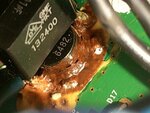TakesBlackMetalSrsly
Newbie level 2
My Logitech
 Z5500 won't turn on so I opened up the subwoofer to look for anything obvious. I found this inside on the circuit board opposite the big heat sinks on the back of the unit. Is this normal in appearance? What is this part and would it's failure cause the unit to not power on? Also, the fuse is not blown. I appreciate your help and have a look forward to hearing from you.
Z5500 won't turn on so I opened up the subwoofer to look for anything obvious. I found this inside on the circuit board opposite the big heat sinks on the back of the unit. Is this normal in appearance? What is this part and would it's failure cause the unit to not power on? Also, the fuse is not blown. I appreciate your help and have a look forward to hearing from you.
 Z5500 won't turn on so I opened up the subwoofer to look for anything obvious. I found this inside on the circuit board opposite the big heat sinks on the back of the unit. Is this normal in appearance? What is this part and would it's failure cause the unit to not power on? Also, the fuse is not blown. I appreciate your help and have a look forward to hearing from you.
Z5500 won't turn on so I opened up the subwoofer to look for anything obvious. I found this inside on the circuit board opposite the big heat sinks on the back of the unit. Is this normal in appearance? What is this part and would it's failure cause the unit to not power on? Also, the fuse is not blown. I appreciate your help and have a look forward to hearing from you.